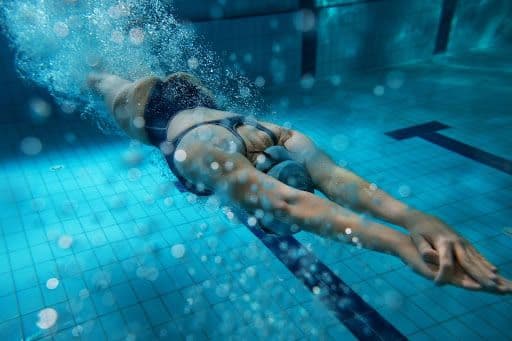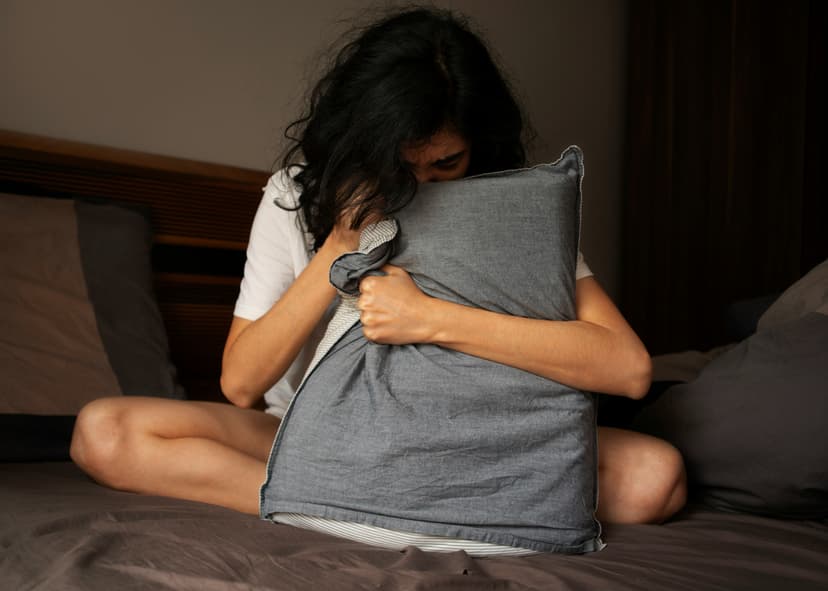Can You Swim With Your Period? Everything You Actually Need to Know
This guide explains how water pressure affects flow, which products work best (tampons, menstrual cups, and period swimwear), and why pads aren’t ideal for swimming. Learn how swimming may relieve cramps and boost mood, when heavy flow or severe pain might make you skip the water, and practical tips for planning, product choice, and post-swim care. Science-backed answers dispel myths and help you enjoy the pool, beach with confidence.


You've got beach plans. Pool party invitations. A vacation booked. Then you check your calendar and realize your period might show up right in the middle of everything.
The question can you go swimming on your period comes up for almost everyone who menstruates. Maybe you've heard conflicting advice, worried about leaks, or been told swimming during menstruation is somehow "unhygienic."
Here's the straightforward answer: Yes, you can absolutely swim on your period. Not only is swimming on your period safe, research shows physical activity during menstruation can actually help with common symptoms like cramping and mood changes.
What actually happens when you swim during your period? Which products work and which don't? How do you feel confident in the water no matter where you are in your cycle?
Can You Go Swimming On Your Period?
Can you go swimming on your period? Absolutely, and there's no medical reason not to.
Despite persistent myths and cultural taboos, menstruation doesn't make swimming dangerous, unhygienic, or impossible. The chlorine in pools effectively kills bacteria and other microbes, treating menstrual fluid just as handling sweat and other bodily fluids. Ocean and lake swimming are also safe, though some healthcare providers recommend chlorinated pools for those concerned about infections.
What about sharks? Another myth worth addressing: there's no evidence that swimming on your period attracts sharks. Marie Levine, founder of The Shark Research Institute, has been diving for decades including while menstruating and has never had an issue with shark interest. Professional divers and marine biologists confirm that sharks show no particular attraction to menstrual blood versus any other bodily fluid.
The real question isn't whether you can swim on your period, but rather how to do so comfortably. The right menstrual products make all the difference.
Does Menstrual Flow Stop In Water?
Many people wonder: does menstrual flow stop in water? Not exactly, but water pressure does affect how blood flows.
When you're submerged in water, external pressure from the water temporarily counteracts gravity's effect on your menstrual flow. Your period doesn't actually stop, your uterus continues shedding its lining but blood doesn't flow out at the same rate.
Think of holding a bottle of water upside down underwater. The water inside doesn't pour out because of surrounding pressure. Something similar happens with menstrual blood while you're submerged.
However, if you cough, sneeze, laugh hard, or do something that increases abdominal pressure, some blood may be released into the water. The amount typically stays minimal and quickly dilutes, making notice unlikely.
Once you exit the water, your flow resumes its normal pattern. That's why using appropriate menstrual products matters: they catch the flow before and after swimming, even if less blood is released while you're actually in the water.
Best Period Products For Swimming
Not all menstrual products work well for swimming on your period. Here's what actually works:
Tampons For Swimming
Tampons remain one of the most popular options for swimming during your period. Insert a fresh tampon before entering the water so absorbing menstrual blood happens rather than pool or ocean water.
How to use tampons while swimming:
- Insert a fresh tampon right before swimming
- Choose the absorbency level appropriate for your flow
- Tuck the string inside your swimsuit if you're self-conscious
- Change the tampon immediately after swimming, as some water absorption may have occurred
The main drawback: tampons can absorb pool or seawater, which means changing them after your swim even if they're not full makes sense.
Menstrual Cups For Swimming
Menstrual cups made from medical-grade silicone create a seal around the cervix and collect (rather than absorb) menstrual blood. Because they don't absorb water like tampons do, menstrual cups work particularly effectively for swimming.
Benefits for swimming:
- Won't absorb pool or ocean water
- Can stay in place for up to 12 hours
- No need to change immediately after swimming (unless full)
- Creates a tight seal to prevent leaks
- Environmentally friendly and reusable
Many swimmers prefer menstrual cups because going straight from the pool to other activities happens without worrying about changing products right away.
Period-Friendly Swimwear
Period swimwear looks like regular bathing suits but includes built-in absorbent layers designed to catch menstrual flow. These work best for light to moderate flow days.
How period swimwear works:
- Waterproof outer layer prevents water from getting in
- Absorbent inner layer catches menstrual blood
- Designed to wear instead of (not with) regular swimsuits
- Quick-drying materials
Most brands recommend period swimwear for lighter flow days, as absorbent capacity stays limited compared to tampons or cups.
Can You Use Period Pads For Swimming?
Period pads for swimming aren't recommended. Pads are highly absorbent, which means immediately soaking up pool or ocean water instead of menstrual blood. Wet pads lose their adhesive and can slip out of your swimsuit.
If pads are your only option and you want to be near water, consider:
- Wearing dark-colored shorts over your swimsuit to secure the pad
- Staying at the pool's edge with just your feet in the water
- Sitting on the beach rather than going in the ocean
However, for actual swimming, tampons, menstrual cups, or period swimwear work far better.
Common Myths About Swimming On Your Period
Let's clear up some persistent misconceptions about swimming on your period:
Myth: Swimming On Your Period Is Unhygienic
Fact: Chlorine in pools kills bacteria and treats menstrual fluid the same way handling sweat and other bodily fluids happens. Menstrual blood contains blood, vaginal fluids, and proteins all of which swimming pool treatment systems easily manage.
As long as you're using appropriate menstrual products, no hygiene concern exists. Swimming pools get designed to handle biological materials safely.
Myth: You'll Attract Sharks
Fact: Despite being a common worry, zero scientific evidence shows menstrual blood attracts sharks. Sharks can detect small amounts of blood in water, but they show no particular interest in menstrual blood versus any other bodily fluid.
Experienced divers, including those who study sharks professionally, confirm they've never had issues swimming or diving while menstruating.
Myth: Swimming Makes Cramps Worse
Fact: The opposite actually holds true. Exercise, including swimming, often relieves menstrual cramps rather than worsening them.
During and after physical activity, your body releases endorphins, natural pain-relieving compounds that also elevate mood. The buoyancy and gentle resistance of water provide particularly soothing movement for cramping muscles.
Myth: Everyone Will Know You're On Your Period
Fact: With appropriate menstrual products (tampons, menstrual cups, or period swimwear), no one can tell you're menstruating. Tampons and menstrual cups stay internal and completely hidden. Period swimwear looks identical to regular swimsuits.
If you're still concerned, darker-colored swimwear can provide extra confidence, though leaks stay unlikely with properly used products.
Health Benefits of Swimming During Menstruation
Swimming on your period isn't just safe, benefits can actually emerge.
Reduces Menstrual Cramps
Swimming and other aerobic exercise help relieve menstrual cramping. Research shows exercise releases endorphins, which act as natural painkillers and mood elevators.
The water's buoyancy also reduces pressure on your lower body, while the gentle resistance provides soothing movement for cramping abdominal and back muscles.
Improves Mood and Reduces PMS Symptoms
Studies indicate swimming can reduce symptoms associated with premenstrual syndrome, including mood swings, irritability, and anxiety.
Physical activity affects neurotransmitter systems in ways that support mood regulation. Swimming combines beneficial movement with the calming effects of being in water, which many people find naturally soothing.
Supports Overall Well-Being
Regular exercise throughout your cycle supports overall menstrual health. Women who maintain consistent physical activity often report more regular cycles and less severe symptoms compared to those who stay sedentary.
Swimming offers low-impact cardiovascular exercise that's gentle on joints making access possible even when experiencing discomfort or fatigue.
When Swimming Might Feel Uncomfortable
While swimming on your period stays safe for most people, times exist when you might choose to skip:
Very Heavy Flow Days
If you're experiencing unusually heavy bleeding (soaking through a pad or tampon every hour), feeling more comfortable avoiding swimming makes sense. Super-absorbent tampons or menstrual cups can hold significant amounts up to 35ml or about 2 tablespoons of blood but very heavy flow can still feel unmanageable.
If heavy bleeding stays typical for you, talk with your healthcare provider. Conditions like endometriosis or fibroids can cause excessive menstrual bleeding and may need treatment.
Severe Cramping or Pain
While mild to moderate cramping often improves with swimming, severe pain (dysmenorrhea) might make preferring to rest more appealing. Listen to your body.
If menstrual pain regularly interferes with activities you enjoy, that's worth addressing. Severe period pain shouldn't control your life, and various approaches can help from hormone-free options to understanding how pain signals work.
Other Symptoms
If you're experiencing fever, nausea, dizziness, or feeling generally unwell during your period, staying home to rest makes more sense than heading to the pool. While these symptoms can occasionally accompany menstruation, they're worth mentioning to your doctor if they're severe or recurring.
Planning Around Your Cycle
One of the best ways to feel confident about swimming on your period involves knowing when to expect it.
Tracking your menstrual cycle helps you:
- Predict when your period will start
- Plan activities around heavier flow days
- Pack appropriate products before trips
- Notice patterns in symptoms across different cycle phases
The Samphire app helps you track over 250 symptoms throughout your cycle, including flow intensity, cramping, mood changes, energy levels, and more. Using neuroscience-informed algorithms, the app identifies your personal patterns so anticipating when symptoms are likely and planning accordingly becomes possible.
What makes cycle tracking particularly valuable: many people notice their symptoms vary not just during menstruation, but across different phases of the entire cycle. Recent research using high-resolution imaging shows hormonal fluctuations throughout your cycle affect how your body processes everything from pain to mood to energy.
Understanding your patterns means scheduling beach vacations during phases when you typically feel your best becomes possible, or simply knowing to pack your preferred menstrual products if swimming plans fall during your period.
Hormone-Free Support Throughout Your Cycle
For those dealing with significant menstrual symptoms that affect activities like swimming, options exist beyond typical medications.
In the United States, Lutea™ offers a wellness-focused approach to support calm, focus, and clarity during hormonally sensitive moments. Hormone-free and drug-free, Lutea™ helps you feel more grounded throughout your cycle making enjoying activities easier without being sidelined by discomfort or mood changes.
For EU and UK readers, Nettle™ is a CE-certified Class IIa medical device using gentle neurostimulation to help with menstrual pain and mood symptoms. Research demonstrates non-invasive neurostimulation can influence how neural circuits process pain signals and regulate mood.
The WIND trial confirmed Nettle's effectiveness for menstrual symptoms, and the device gets backed by trials funded by NHS and other organizations.
Nettle™ features:
- Hormone-free and drug-free
- Clinically proven to reduce menstrual pain
- Just 20 minutes per day, 5 days per cycle
- Includes Samphire membership with comprehensive cycle tracking
Whether managing mild PMS, severe PMDD, or simply wanting to feel more incontrol throughout your cycle, understanding your patterns and having the right support makes all the difference.
Your Period Shouldn't Stop You From Swimming
Can you go swimming on your period? Yes safely, hygienically, and comfortably.
With the right menstrual products (tampons, menstrual cups, or period swimwear), enjoying swimming, surfing, diving, or any water activity throughout your cycle becomes possible. Swimming on your period often helps relieve cramps and improve mood, making physical activity something that actually supports you during menstruation rather than something needing avoidance.
The key: understanding your body's patterns and planning accordingly. Tracking your cycle with tools like the Samphire app helps anticipate when your period will arrive, how heavy your flow might be, and which days you'll feel your best.
For those managing challenging menstrual symptoms, hormone-free and drug-free options exist:
- Lutea™ for wellness-focused support (US)
- Nettle™ for clinically proven relief from menstrual pain and mood symptoms (EU/UK)
Your period stays part of your body's natural rhythm. Understanding what happens during your cycle and having the right products and support means never having to choose between feeling comfortable and doing the activities you love.
Ready to take control of your cycle?
- Get the Samphire app to track your patterns and predict symptoms
- Try Lutea™ for hormone-free cycle support (US)
- Get Nettle™ for clinically proven menstrual relief (EU/UK)
Swimming, beach days, pool parties none of them have to wait. Your period doesn't control your calendar.
For more on cycle-related conditions, visit dysmenorrhea, PMS, PMDD, and endometriosis. See neuroplasticity and our science-backed approach.
Frequently Asked Questions
Can you go swimming on your period without a tampon?
Yes. While tampons stay popular, menstrual cups and period-friendly swimwear also work well for swimming on your period. Menstrual cups don't absorb water like tampons do, so changing them immediately after swimming isn't necessary. Period swimwear gets designed specifically for swimming during menstruation and works for light to moderate flow days.
If you prefer not to use any internal products, period swimwear gives protection without insertion.
Does menstrual flow stop in water?
Not completely, but water pressure does temporarily slow the flow. When you're submerged, external water pressure counteracts gravity's effect on your menstrual blood, meaning less blood flows out while you're actually in the water.
However, your uterus continues its normal shedding process. Once you exit the water, flow resumes at its usual rate. Activities that increase abdominal pressure (coughing, sneezing, laughing) can also cause some blood release even while you're in the water.
Using appropriate menstrual products ensures protection before and after swimming, regardless of how water pressure affects flow during your swim.
Can you use period pads for swimming?
Period pads for swimming don't work well. Pads get designed to absorb liquid, which means immediately soaking up pool or ocean water instead of catching menstrual blood. Once wet, pads lose their adhesive backing and can slip out from under your swimsuit.
For actual swimming, choose tampons, menstrual cups, or period swimwear instead. If pads are your only option, wearing dark shorts over your swimsuit and wading in shallow water rather than fully swimming becomes necessary.
Will swimming make my period cramps worse?
No. Swimming typically helps relieve menstrual cramps rather than worsening them. Exercise releases endorphins, your body's natural pain-relieving compounds which can significantly reduce cramping.
The buoyancy of water also takes pressure off your lower back and abdomen, while the gentle resistance provides soothing movement. Many people find water-based exercise particularly comfortable during menstruation.
If you have severe cramping that exercise doesn't help, that's worth discussing with your healthcare provider. Conditions like endometriosis or severe dysmenorrhea can cause debilitating pain that requires specific treatment.
How do Olympic swimmers manage their periods?
Professional swimmers use the same products available to everyone: primarily tampons and menstrual cups. Many athletes competing at high levels use menstrual cups because they can stay in place for up to 12 hours and don't need changing between events.
Some athletes also use hormonal birth control to manipulate their cycles, either skipping periods entirely or timing them to avoid major competitions. However, regular menstrual products work perfectly well for recreational swimming.
Olympic swimmer Kelsi Worrell has spoken openly about managing periods during competition, noting "nothing is too embarrassing" and that handling menstruation stays simply part of being a female athlete.
Is it hygienic to swim on your period?
Yes, swimming on your period stays hygienic when you use appropriate menstrual products. Chlorine in swimming pools kills bacteria and effectively treats menstrual fluid the same way handling sweat and other bodily substances happens.
Menstrual blood consists of blood, vaginal fluids, and proteins all of which standard pool treatment systems manage. As long as you're using tampons, menstrual cups, or period swimwear (not pads, which don't work for swimming), no hygiene concerns exist.
Some healthcare providers suggest avoiding lakes or oceans if you're concerned about infections, since natural bodies of water can't get treated with chlorine. However, many people swim in natural waters during menstruation without issues.
Will everyone know I'm on my period?
No. With proper menstrual products, no one can tell you're menstruating. Tampons and menstrual cups stay internal and completely hidden. Period swimwear looks identical to regular bathing suits.
If you're still self-conscious, darker-colored swimwear (navy, black, dark purple) can provide extra confidence, though leaks stay unlikely when products get used correctly.
Getting your period shouldn't stop you from enjoying water activities. Approximately 1.8 billion people menstruate each month. You're definitely not alone at the pool or beach.
Related Articles

13 Foods to Eat During Your Period: What To Avoid for Better Relief
Learn which foods to eat and avoid during your period to reduce cramps, bloating, and fatigue. Support hormone balance, mood, and energy naturally with nutrient-rich, anti-inflammatory foods like leafy greens, fish, and sweet potatoes.

Why does my period feel different from last month?
Have you ever wondered why your period can vary so much? Learn about the science behind it.